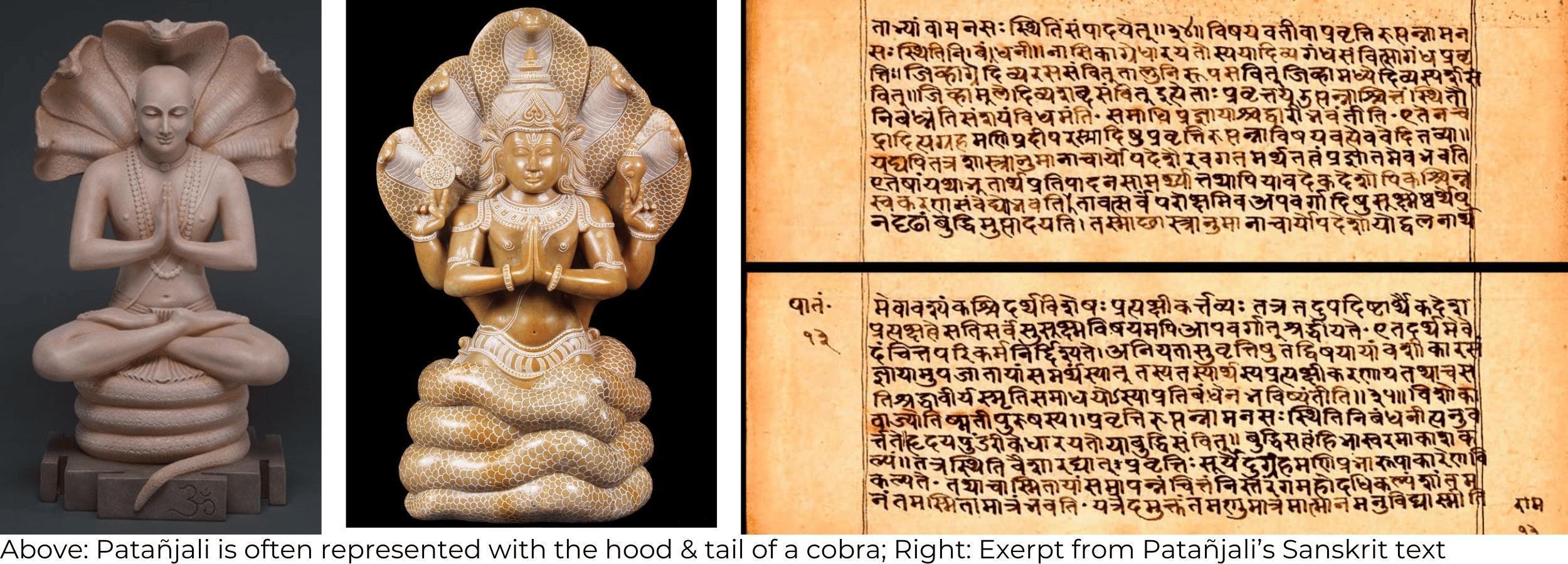We might assume that Patanjali's Yoga Sutras are about yoga; the popular postural practice found in wellness centres the world over. However, in ancient India, 'yoga' meant 'meditation'. The postures were less 'warrior' or 'tree' pose, and more seated postures conducive to long periods of contemplation. It may help, therefore, whenever you come across Patanjali's Yoga Sutras, to replace the word 'yoga' with 'meditation'.
As anyone who has attended a course at The College of Psychic Studies well knows, meditation is an essential ingredient to our psychic mediumship development. So Patanjali's Yoga Sutras are more relevant to us than we may realise. Not only do these short, clever phrases detail a roadmap to the awakening of consciousness, they also suggest that psychic abilities can be developed through an earnest meditation practice. So what can we, as students of psychic development, glean from Patanjali's Yoga Sutras to support our awakening process?

What are the Yoga Sutras of Patanjali?
The Yoga Sutras is an ancient collection of 196 aphorisms, written sometime between the 2nd century BCE and the 4th century CE, that describe with great clarity a roadmap of spiritual awakening. The sutras are divided into four chapters, or padas, each of which addresses different aspects of the spiritual journey:
Samadhi Pada (Chapter on Contemplation): This chapter discusses the nature of the mind and the obstacles to yoga (read meditation). It also outlines the various stages of meditation. It introduces the concept of 'Samadhi,' the state of spiritual absorption and union with all that is, the divine.
Sadhana Pada (Chapter on Practice): This chapter provides guidance on the practical aspects of yoga (again, read meditation). It outlines a progressive actionable path to self-realisation, including ethical principles (Yamas and Niyamas), seated postures (Asana), breath control (Pranayama), withdrawal of the senses (Pratyahara), concentration (Dharana), meditation (Dhyana), and Samadhi.
Vibhuti Pada (Chapter on Accomplishments): This chapter delves into the supernatural and mystical aspects of yoga. It describes the potential siddhis (powers or accomplishments) that may arise as a result of deep meditation and practice. One of these powers is psychic abilities, another is to teleport at will. Patanjali cautions against becoming attached to these siddhis and emphasises the importance of remaining focused on the path to self-realisation.
Kaivalya Pada (Chapter on Liberation): The final chapter discusses the ultimate goal of yoga, which is liberation (kaivalya). It explores the nature of the self, the concept of purusha (the pure consciousness), and the idea of detachment from the material world. It concludes by describing the state of absolute freedom and oneness with the divine.
What can we learn from the Yoga Sutras?
Having survived the test of time, Patanjali's Yoga Sutras provide a trusted and comprehensive guide for those of us on a path toward self-realisation and spiritual growth. They detail preparatory practices that open the gate to increasingly sublime and refined states of consciousness. Here are some of the key teachings and lessons that can be learned from the Yoga Sutras:
Stilling the Mind: Patanjali defines yoga (meditation) as the cessation of the fluctuations of the mind (chitta vritti nirodha). This is achieved through the lifestyle choices he outlines in the point below. This asserts, once more, that his meaning of yoga is primarily a mental and spiritual practice, aiming to still the mind and attain inner peace.
Steps on the path to awakening: Patanjali outlines the eight limbs of yoga, which provide a systematic path to self-realisation. These limbs include Yama (ethical principles), Niyama (self-discipline), Asana (postures appropriate for meditation or to help prepare for long bouts of sitting), Pranayama (breath control), Pratyahara (withdrawal of the senses), Dharana (concentration), Dhyana (meditation), and Samadhi (absorption or union with the divine). These limbs guide us in our journey toward self-awareness and spiritual growth.
An ethical lifestyle: The Yamas and Niyamas, the first two limbs of yoga, provide us with a moral and ethical framework. They include principles like non-violence, truthfulness, non-stealing, self-discipline, and contentment. These guidelines help us lead a more balanced and ethical life.
Breath control: Pranayama techniques are introduced as a means of controlling the breath and vital energy (prana). This practice helps purify the body and mind, leading to better concentration and a deeper meditative state.
Withdrawal of the senses (pratyahara): Pratyahara involves directing one's attention inward by withdrawing it from external sensory experiences. This prepares the mind for deeper states of meditation.
Concentration (Dharana) and meditation (Dhyana): These two limbs are essential components of the yogic path. Concentration involves focusing the mind on a single point, while meditation is the sustained concentration on a particular object or thought. Both are steps leading to Samadhi, the ultimate goal of yoga.
Samadhi: Samadhi represents the state of union or absorption, where our sense of self dissolves, and we experience oneness with the object of meditation or the divine. It is the culmination of our awakening journey.
Suffering and liberation: Patanjali's Yoga Sutras acknowledge the human experience of suffering (duhkha) and offer a path to liberation (kaivalya) from this suffering. Through disciplined practice, one can transcend the cycle of birth and death (samsara) and achieve spiritual liberation.
The teachings emphasise ethical living, mental control, and the journey toward a state of oneness and liberation. Many on the spiritual path continue to draw inspiration from these ancient texts in their pursuit of a more meaningful and conscious life.
How old are Patanjali's Yoga Sutras?
Patanjali is traditionally credited with compiling and codifying the existing knowledge and practices of yoga into the form of the sutras, which are written in Sanskrit and are highly concise and systematic in their presentation. The exact date of when Patanjali's Yoga Sutras were composed is a subject of debate among scholars, and there is no definitive historical record to establish an exact date. However, it is generally believed that the Yoga Sutras were composed by the sage Patanjali sometime between the 2nd century BCE and the 4th century CE.
It's important to note that Patanjali's identity and the historical context of his work remain somewhat mysterious. Some scholars even suggest that Patanjali might have been a title or a group of scholars rather than a single individual. Nevertheless, the Yoga Sutras have had a profound and lasting influence on the development of our contemporary spiritual and philosophical traditions.
See what's on at The College of Psychic Studies:

Join our newsletter for more articles like this one.





